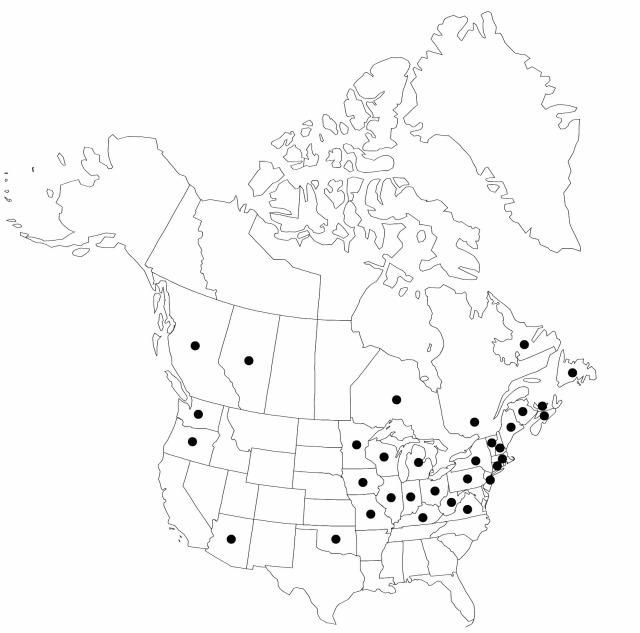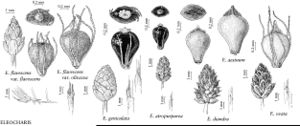Eleocharis ovata
in J. J. Roemer et al., Syst. Veg. 2: 152. 1817.
Culms 2–35 cm × 0.3–1 mm. Leaves: apex of distal leaf sheath obtuse to acute, tooth to 0.2 mm. Spikelets ovoid, 2–8 × 2–4 mm, apex acute (to blunt); floral scales 25–100+, ca. 10 per mm of rachilla, orange-brown, rarely stramineous, ovate, 1.5–2 × 1 mm, midribs often keeled in distal part of spikelet, apex rounded to subacute. Flowers: perianth bristles present, rarely absent, (5–)6–7, brown, fairly slender, exceeding tubercle; stamens 2(–3); anthers brown, 0.3 mm; styles 2-fid or some 3-fid. Achenes 0.75–1 × 0.6–0.85 mm. Tubercles deltoid, 0.3–0.5 × 0.3–0.5 mm, 3/5 of to as high as wide, 1/3–2/3 as high and 1/2–3/4 as wide as achene. 2n = 10.
Phenology: Fruiting summer–fall.
Habitat: Fresh, often drying shores, lake and stream beds, bogs, tidal estuaries, disturbed places
Elevation: 10–700 m (East), 1500–2000 m (Arizona)
Distribution

Alta., B.C., N.B., Nfld. and Labr., N.S., Ont., P.E.I., Que., Ariz., Conn., Ill., Ind., Iowa, Ky., Maine, Mass., Mich., Minn., Mo., N.H., N.J., N.Y., Ohio, Okla., Oreg., Pa., Vt., Va., Wash., W.Va., Wis., Eurasia.
Discussion
Although Eleocharis ovata has often been confused with E. obtusa, B. M. H. Larson and P. M. Catling (1996) showed that these species may be distinguished by non-overlapping widths of the tubercles, at least in Canada. The records of E. ovata in New Brunswick, Newfoundland, Nova Scotia, and Prince Edward Island are based on B. M. H. Larson and P. M. Catling (1996) and the records in Illinois, Indiana, Missouri, Montana, New Jersey, Oregon, and Washington are based on D. M. Hines (1975). Eleocharis ovata probably also occurs in Manitoba and Saskatchewan.
Selected References
None.
